FYI: 11 S. Sataluri
Obsoletes: 1292 AT&T Bell Laboratories
Category: Informational Editors
May 1994
A Revised Catalog of Available X.500 Implementations
Status of this Memo
This memo provides information for the Internet community. This memo
does not specify an Internet standard of any kind. Distribution of
this memo is unlimited.
Abstract
This document is the result of a survey that gathered new or updated
descriptions of currently available implementations of X.500,
including commercial products and openly available offerings. This
document is a revision of RFC1292. We contacted each contributor in
RFC1292 and requested an update and published the survey template in
several mailing lists and obtained new product descriptions.
This document contains detailed description of twenty six (26) X.500
implementations - DSAs, DUAs, and DUA interfaces.
1. Introduction
This document catalogs currently available implementations of X.500,
including commercial products and openly available offerings. For
the purposes of this survey, we classify X.500 products as,
DSA
A DSA is an OSI application process that provides the Directory
functionality,
DUA
A DUA is an OSI application process that represents a user in
accessing the Directory and uses the DAP to communicate with a
DSA, and
DUA Interface
A DUA Interface is an application process that represents a user
in accessing the Directory using either DAP but supporting only
a subset of the DAP functionality or a protocol different from
DAP to communicate with a DSA or DUA.
Section 2 of this document contains a listing of implementations
cross referenced by keyword. This list should aid in identifying
implementations that meet your criteria.
To compile this catalog, the IDS Working Group solicited input from
the X.500 community by surveying several Internet mailing lists,
including: iso@nic.ddn.mil, isode@nic.ddn.mil, osi-ds@cs.ucl.ac.uk,
and ietf-ids@umich.edu. We also contacted many people by telephone
and sent the template to several individuals and mailed a floppy disk
containing the survey template to a person who did not have Internet
access.
Readers are encouraged to submit comments regarding both the form and
content of this memo. New submissions are welcome. Please direct
input to the Integrated Directory Services (IDS) Working Group
(ietf-ids@umich.edu) or to the editors. IDS will produce new ver-
sions of this document when a sufficient number of changes have been
received. This will be determined by the IDS chairpersons.
1.1 Purpose
The Internet has experienced a steady growth in X.500 piloting
activities. This document hopes to provide an easily accessible
source of information on X.500 implementations for those who wish to
consider X.500 technology for deploying a Directory service.
1.2 Scope
This document contains descriptions of both free and commercial X.500
implementations. It does not provide instructions on how to install,
run, or manage these implementations. The descriptions and indices
are provided to make the readers aware of available options and thus
enable more informed choices.
1.3 Disclaimer
Implementation descriptions were written by implementors and vendors,
and not by the editors. We worked with the description authors to
ensure uniformity and readability, but can not guarantee the accuracy
or completeness of the descriptions, or the stability of the
implementations.
1.4 Overview
Section 1 contains introductory information.
Section 2 contains a list of keywords, their definitions, and a cross
reference of the X.500 implementations by these keywords.
Section 3 contains the X.500 implementation descriptions.
Section 4 has a list of references.
Section 6 lists the editors' addresses.
1.5 Acknowledgments
The creation of this catalog would not have been possible without the
efforts of the description authors and the members of the IDS Working
Group. Our special thanks to the editors of RFC1292, Ruth Lang and
Russ Wright who helped us get started and made key suggestions that
enabled us to learn from their experience. We also acknowledge and
appreciate the efforts of Ken Rossen in obtaining six descriptions.
2. Keywords
Keywords are abbreviated attributes of the X.500 implementations.
The list of keywords defined below was derived from the
implementation descriptions themselves. Implementations were indexed
by a keyword either as a result of: (1) explicit, not implied,
reference to a particular capability in the implementation
description text, or (2) input from the implementation description
author(s).
2.1 Keyword Definitions
This section contains keyword definitions. They have been organized
and grouped by functional category. The definitions are ordered
first alphabetically by keyword category, and second alphabetically
by implementation name within keyword category.
2.1.1 Availability
Available via FTP
Implementation is available using FTP.
Commercially Available
This implementation can be purchased.
Free
Available at no charge, although other restrictions may apply.
Limited Availability
Need to contact provider for terms and conditions of
distribution.
Source
Source code is available, potentially at an additional cost.
2.1.2 Conformance with Proposed Internet Standards
These RFCs specify standards track protocols for the Internet
community. Implementations which conform to these evolving proposed
standards have a higher probability of interoperating with other
implementations deployed on the Internet.
RFC-1274
Implementation supports RFC1274: Barker, P., and S. Kille, The
COSINE and Internet X.500 Schema, University College, London,
England, November 1991.
RFC-1276
Implementation supports RFC1276: Kille, S., Replication and
Distributed Operations extensions to provide an Internet
Directory using X.500, University College, London, England,
November 1991.
RFC-1277
Implementation supports RFC1277: Kille, S., Encoding Network
Addresses to support operation over non-OSI lower layers,
University College, London, England, November 1991.
RFC-1485
Implementation supports RFC1485: Kille, S., A String
Representation of Distinguished Names, ISODE Consortium, July
1993.
RFC-1487
Implementation supports RFC1487: Yeong, W., T. Howes, and S.
Kille, X.500 Lightweight Directory Access Protocol, July 1993.
2.1.3 Consistence with Informational and Experimental Internet RFCs
These RFCs provide information to the Internet community and are not
Internet standards. Compliance with these RFCs is not necessary for
interoperability but may enhance functionality.
RFC-1202
Implementation supports RFC1202: Rose, M. T., Directory
Assistance Service. February 1991.
RFC-1249
Implementation supports RFC1249: Howes, T., M. Smith, and B.
Beecher, DIXIE Protocol Specification, University of Michigan,
August 1991.
RFC-1275
Implementation supports RFC1275: Kille, S., Replication
Requirements to provide an Internet Directory using X.500,
University College, London, England, November 1991.
RFC-1278
Implementation supports RFC1278: Kille, S., A string encoding
of Presentation Address, University College, London, England,
November 1991.
RFC-1279
Implementation supports RFC1279: Kille, S., X.500 and Domains,
University College, London, England, November 1991.
RFC-1484
Implementation supports RFC1484: Kille, S., Using the OSI
Directory to achieve User Friendly Naming, ISODE Consortium,
July 1993.
2.1.4 Implementation Type
API
Implementation comes with an application programmer's interface
(i.e., a set of libraries and include files).
DSA Only
Implementation consists of a DSA only. No DUA is included.
DSA/DUA
Both a DSA and DUA are included in this implementation.
DUA Interface
Implementation is a DUA-like program that uses either DAP, but
supporting only a subset of the DAP functionality, or uses a
protocol different from DAP to communicate with a DSA or DUA.
DUA Only
Implementation consists of a DUA only. No DSA is included.
LDAP
DUA interface program uses the Lightweight Directory Access
Protocol (LDAP).
2.1.5 Internetworking Environment
CLNS
Implementation operates over the OSI ConnectionLess Network
Service (CLNS).
OSI Transport
Implementation operates over one or more OSI transport
protocols.
RFC-1006
Implementation operates over RFC-1006 with TCP/IP transport
service. RFC-1006 is an Internet Standard.
X.25
Implementation operates over OSI X.25.
2.1.6 Pilot Connectivity
DUA Connectivity
The DUA can be connected to the pilot, and information on any
pilot entry looked up. The DUA is able to display standard
attributes and object classes and those defined in the COSINE
and Internet Schema.
DSA Connectivity
The DSA is connected to the DIT, and information in this DSA is
accessible from any pilot DUA.
2.1.7 Miscellaneous
Included in ISODE
DUAs that are part of ISODE.
Limited Functionality
Survey states that the implementation has some shortcomings or
intended lack of functionality, e.g., omissions were part of the
design to provide an easy-to-use user interface.
Motif
Implementation provides a Motif-style X Window user interface.
Needs ISODE
ISODE is required to compile and/or use this implementation.
OpenLook
Implementation provides an OpenLook-style X Window user
interface.
X Window System
Implementation uses the X Window System to provide its user
interface.
2.1.8 Operating Environment
386
Implementation runs on a 386-based platform.
Bull
Implementation runs on a Bull platform.
CDC
Implementation runs on a CDC MIPS platform.
DEC ULTRIX
Implementation runs under DEC ULTRIX.
DEC Vax OpenVMS
Implementation runs on a DEC VAX platform running OpenVMS.
HP
Implementation runs on an HP platform.
IBM PC
Implementation runs on a PC.
IBM RISC
Implementation runs on IBM's RISC UNIX workstation.
ICL
Implementation runs on an ICL platform.
Macintosh
Implementation runs on a Macintosh.
Multiple Vendor Platforms
Implementation runs on more than one hardware platform.
Sequent
Implementation runs on a Sequent platform.
SNI
Implementation runs on a Siemens Nixdorf platform.
Solbourne
Implementation runs on a Solbourne platform.
Sun
Implementation runs on a Sun platform.
Tandem
Implementation runs on a Tandem platform.
UNIX
Implementation runs on a generic UNIX platform.
Wang
Implementation runs on a Wang RISC platform.
2.2 Implementations Indexed by Keyword
This section contains an index of implementations by keyword. You
can use this list to identify particular implementations that meet
your chosen criteria.
The index is organized as follows: keywords appear in alphabetical
order; implementations characterized by that keyword are listed
alphabetically as well. Note that a "*" is used to indicate that the
particular implementation, or feature of the implementation, may not
be available at this time.
For formatting purposes, we have used the following abbreviations for
implementation names: BULL S.A. (Bull X500-DS and X500-DUA), DEC
X.500 DSA (DEC X.500 Directory Server), DEC X.500 Admin (DEC X.500
Administration Facility), HP X.500 DD (HP X.500 Distributed
Directory), LDAP (University of Michigan LDAP Implementation), OSI
Access & Dir (OSI Access and Directory), and Traxis (Traxis
Enterprise Directory).
386 CLNS
]]>
C6000系列DSP是TI公司生產(chǎn)的高檔DSP。這一系列DSP都是基VelociTITM構(gòu)架的VLIW DSP,它在每個(gè)周期可以執(zhí)行八條32bit 的指令, 具有高達(dá)200MHZ的CPU,從而使得其運(yùn)算能力達(dá)到1600MIPS。而6416在600MHz主頻下,只利用50%的運(yùn)算能力就可以同時(shí)進(jìn)行單通道MPEG-4視頻編碼、單通道MPEG-4視頻解碼和單通道MPEG-2視頻編碼的處理。同時(shí)其對(duì)外接口靈活、開發(fā)工具齊全,被大多數(shù)嵌入式圖像實(shí)時(shí)壓縮系統(tǒng)所采用。因此本系統(tǒng)采用TI公司TMS320C6416芯片為核心處理器。
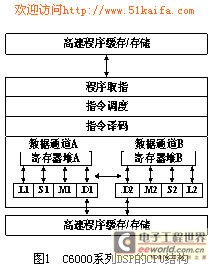
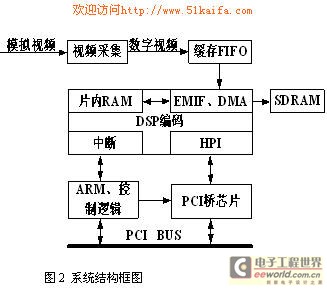
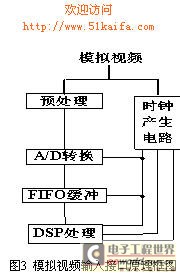
其中ARM7的作用是時(shí)鐘的產(chǎn)生及控制視頻采集芯片,將采得的數(shù)據(jù)從8位或16位轉(zhuǎn)化為32位,并且使數(shù)據(jù)按照Y、U、V分開的方式排列。這樣相當(dāng)于對(duì)采集到的數(shù)據(jù)進(jìn)行了一次預(yù)處理,以便于視頻編碼使用。另外ARM7將32位寬的數(shù)據(jù)輸出給32位的FIFO。用32位的FIFO以及將視頻數(shù)據(jù)轉(zhuǎn)換為32位,可以使DSP讀取視頻數(shù)據(jù)時(shí)32位的數(shù)據(jù)總線沒(méi)有空閑,從而提高DSP讀取視頻數(shù)據(jù)的效率;這里使用FIFO是為了減少DSP讀取數(shù)據(jù)的時(shí)間、降低高速設(shè)備和低速設(shè)備的不匹配。每次FIFO半滿時(shí),ARM7會(huì)給DSP發(fā)送中斷信號(hào), 并且在中斷處理程序中使用DMA方式讀取視頻數(shù)據(jù);如果不使用ARM7,DSP會(huì)頻繁中斷,從而花費(fèi)大量時(shí)間在入棧、出棧以及寄存器的設(shè)置上。
但是DMA 只適合于數(shù)據(jù)塊的整體搬移,對(duì)于不同數(shù)據(jù)結(jié)構(gòu)間的數(shù)據(jù)傳輸,前DSP 的DMA 控制器就無(wú)能為力了。所以可以借助ARM7控制DSPDMA 來(lái)完成視頻編碼中復(fù)雜的數(shù)據(jù)傳輸。
完成編碼后的視頻數(shù)據(jù)通過(guò)ARM7來(lái)進(jìn)行和外界的傳輸,可以通過(guò)Internet、 CDMA或者GSM網(wǎng)絡(luò)等,只需要ARM7設(shè)計(jì)相應(yīng)的傳輸接口即可。至于ARM7與編碼卡通信可以通過(guò)并口、串口、USB口、PCI接口等方式實(shí)現(xiàn)。其中PCI 接口方式易于ARM7與編碼器高速傳輸數(shù)據(jù),因此可以采用PCI接口。編碼后的數(shù)據(jù)通過(guò)DSP的HPI、PCI橋芯片、PCI總線到達(dá)ARM7。ARM7通過(guò)DSP的HPI直接對(duì)DSP的存儲(chǔ)空間進(jìn)行訪問(wèn)。
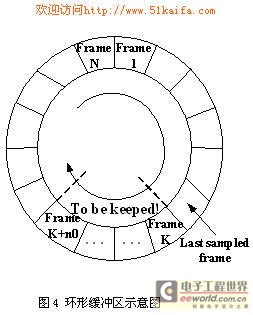
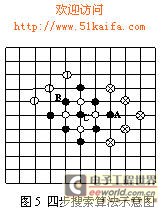
圖5 四步搜索算法示意圖